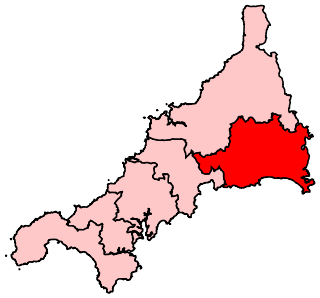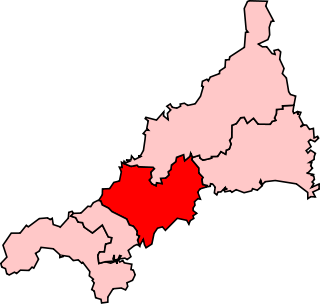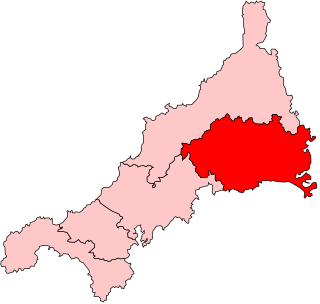| East Looe | |
|---|---|
| Former Borough constituency for the House of Commons | |
| County | Cornwall |
| Major settlements | East Looe |
| 1571–1832 | |
| Seats | Two |
| Replaced by | East Cornwall |
East Looe was a parliamentary borough represented in the House of Commons of England from 1571 to 1707, in the House of Commons of Great Britain from 1707 to 1800, and finally in the House of Commons of the United Kingdom from 1801 until its abolition in 1832. It elected two Members of Parliament (MP) by the bloc vote system of election. It was disenfranchised in the Reform Act 1832.
The borough consisted of the town of East Looe in Cornwall, connected by bridge across the River Looe to West Looe, which was also a parliamentary borough. From the reign of Edward VI, East Looe and West Looe were jointly a borough, returning two members of Parliament; however, under Queen Elizabeth the two towns were separated, and each thereafter returned two members except between 1654 and 1658, when they were once again represented jointly as East Looe and West Looe, by one member of the First and Second Protectorate Parliaments.
The right of election was in Mayor and members of the corporation, together with a number of freemen of the borough. [1] Namier and Brooke estimated that there were about fifty voters in this constituency in the second half of the eighteenth century. It is estimated that by 1800 there were still about fifty electors, and in 1831 the number of eligible voters was 38 while the population of the borough was 865.
In practice, this meant that the power to choose the MPs was in the hands of the local landowner or "proprietor", making East Looe (like West Looe) one of the most notorious of the rotten boroughs. The borough was long controlled by the Trelawny family of the nearby manor of Trelawny [2] in the parish of Pelynt. For many years at the time of the Reform Act, East Looe had been controlled by the Buller family of Morval (which also controlled West Looe and Saltash), and many members of the family sat for the borough in the House of Commons.
After the Reform Act 1832 disenfranchised the borough, it reverted to being represented as part of the county constituency covering its area. Cornwall was divided into two divisions in 1832, East Cornwall (with its place of election at Bodmin) and West Cornwall (which voted at Truro). East Looe was located in East Cornwall.
| Parliament | First member | Second member | |
|---|---|---|---|
| Parliament of 1571 | John Wolley | Edward Cordel | |
| Parliament of 1572-1583 | Thomas Stone | Thomas West | |
| Parliament of 1584-1585 | Richard Spencer | Anthony Rous | |
| Parliament of 1586-1587 | Abraham Hartwell | Edward Trelawny | |
| Parliament of 1588-1589 | Anthony Everard | Sir Robert Jermyn | |
| Parliament of 1593 | William Hampden | Gregory Downhall | |
| Parliament of 1597-1598 | Ambrose Bellot | Robert Gawdy | |
| Parliament of 1601 | John Hanham | Robert Yardley | |
| Parliament of 1604-1611 | Sir Robert Phelips | Sir John Parker | |
| Addled Parliament (1614) | George Chudleigh | Sir Reginald Mohun | |
| Parliament of 1621-1622 | Sir John Walter | Sir Jerome Horsey | |
| Happy Parliament (1624-1625) | Bartholomew Specot | ||
| Useless Parliament (1625) | Sir James Bagge | Sir John Trevor | |
| Parliament of 1625-1626 | John Chudleigh | ||
| Parliament of 1628-1629 | William Murray | Paul Specot | |
| No Parliament summoned 1629-1640 | |||

South East Cornwall is a constituency represented in the House of Commons of the UK Parliament since 2010 by Sheryll Murray, a Conservative.

Truro was the name of a parliamentary constituency in Cornwall represented in the House of Commons of England and later of Great Britain from 1295 until 1800, then in the Parliament of the United Kingdom from 1801 to 1918 and finally from 1950 to 1997. Until 1885 it was a parliamentary borough, electing two members of parliament (MPs) by the plurality-at-large system of election; the name was then transferred to the surrounding county constituency, which elected a single Member by the first past the post system. In 1997, although there had been no changes to its boundaries, it was renamed as Truro and St Austell, reflecting the fact that St Austell by then had a larger population than Truro.
Mitchell, or St Michael, was a rotten borough consisting of the town of Mitchell, Cornwall. From the first Parliament of Edward VI, in 1547, it elected two members to the Unreformed House of Commons.
Cornwall is a former county constituency covering the county of Cornwall, in the South West of England. It was a constituency of the House of Commons of England then of the House of Commons of Great Britain from 1707 to 1800 and of the House of Commons of the United Kingdom from 1801 to 1832. It was represented by two Knights of the Shire, elected by the bloc vote system.

Bodmin was the name of a parliamentary constituency in Cornwall from 1295 until 1983. Initially, it was a parliamentary borough, which returned two Members of Parliament to the House of Commons of England and later the House of Commons of the Parliament of the United Kingdom until the 1868 general election, when its representation was reduced to one member.
The UK parliamentary constituency of Seaford was a Cinque Port constituency, similar to a parliamentary borough, in Seaford, East Sussex. A rotten borough, prone by size to undue influence by a patron, it was disenfranchised in the Reform Act of 1832. It was notable for having returned three Prime Ministers as its members – Henry Pelham, who represented the town from 1717 to 1722, William Pitt the Elder from 1747 to 1754 and George Canning in 1827 – though only Canning was Prime Minister while representing Seaford.
West Looe, often spelt Westlow or alternative Westlowe, in Cornwall, England, was a rotten borough represented in the House of Commons of England from 1535 to 1707, in the House of Commons of Great Britain from 1707 to 1800, and in the House of Commons of the United Kingdom from 1801 to 1832. It elected two Members of Parliament (MP) by the bloc vote system of election. It was disfranchised in the Reform Act 1832.
Ilchester was a constituency of the House of Commons of the Parliament of England, then of the Parliament of Great Britain from 1707 to 1800 and of the Parliament of the United Kingdom from 1801 to 1832. It was represented by two Members of Parliament until 1832. It was one of the most notoriously corrupt rotten boroughs.
Bossiney was a parliamentary constituency in Cornwall, one of a number of Cornish rotten boroughs. It returned two members of Parliament to the British House of Commons from 1552 until 1832, when it was abolished by the Great Reform Act.
The Cornish rotten and pocket boroughs were one of the most striking anomalies of the Unreformed House of Commons in the Parliament of the United Kingdom before the Reform Act of 1832. Immediately before the Act Cornwall had twenty boroughs, each electing two members of parliament, as well as its two knights of the shire, a total of 42 members, far in excess of the number to which its wealth, population or other importance would seem to entitle it. Until 1821 there was yet another borough which sent two men to parliament, giving Cornwall only one fewer member in the House of Commons than the whole of Scotland.
Saltash, sometimes called Essa, was a "rotten borough" in Cornwall which returned two Members of Parliament to the House of Commons in the English and later British Parliament from 1552 to 1832, when it was abolished by the Great Reform Act.
St Germans was a rotten borough in Cornwall which returned two Members of Parliament to the House of Commons in the English and later British Parliament from 1562 to 1832, when it was abolished by the Great Reform Act.
St Mawes was a rotten borough in Cornwall, England. It returned two Members of Parliament (MPs) to the House of Commons of England from 1562 to 1707, to the House of Commons of Great Britain from 1707 to 1800, and to the House of Commons of the United Kingdom until it was abolished by the Great Reform Act in 1832.
Plymouth was a parliamentary borough in Devon, which elected two members of parliament (MPs) to the House of Commons in 1298 and again from 1442 until 1918, when the borough was merged with the neighbouring Devonport and the combined area divided into three single-member constituencies.
Portsmouth was a borough constituency based upon the borough of Portsmouth in Hampshire. It returned two members of parliament (MPs) to the Parliaments of England, Great Britain and from 1801 the House of Commons of the Parliament of the United Kingdom, elected by the bloc vote system.
Bere Alston or Beeralston was a parliamentary borough in Devon, which elected two Members of Parliament (MPs) to the House of Commons from 1584 until 1832, when the constituency was abolished by the Great Reform Act as a rotten borough.
Liskeard was a parliamentary borough in Cornwall, which elected two Members of Parliament (MPs) to the House of Commons from 1295 until 1832, and then one member from 1832 until 1885. The constituency was abolished by the Redistribution of Seats Act 1885.
Bramber was a parliamentary borough in Sussex, one of the most notorious of all the rotten boroughs. It elected two Members of Parliament (MPs) to the House of Commons in 1295, and again from 1472 until 1832, when the constituency was abolished by the Great Reform Act.
Wareham was a parliamentary borough in Dorset, which elected two Members of Parliament (MPs) to the House of Commons from 1302 until 1832, and then one member from 1832 until 1885, when the borough was abolished.
Stamford was a constituency in the county of Lincolnshire of the House of Commons for the Parliament of England to 1706 then of the Parliament of Great Britain from 1707 to 1800 and of the Parliament of the United Kingdom from 1801 to 1918. It was represented by two Members of Parliament until 1868 when this was reduced to one.